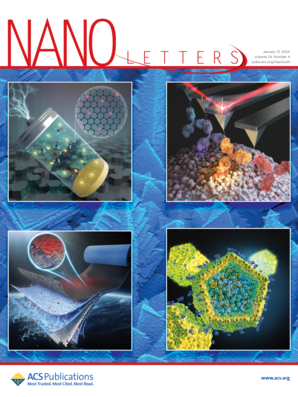纳米沉淀物中的化学短程有序调节平面故障以提高力学性能
IF 9.6
1区 材料科学
Q1 CHEMISTRY, MULTIDISCIPLINARY
引用次数: 0
摘要
纳米沉淀物通过阻碍位错运动来增强金属材料,但它们往往会损害延展性。本研究引入了一种新的策略,通过在纳米沉淀物中加入原子尺度的化学非均质性来解决这一挑战。首次在Co40Ni30Cr20Al5Ti4Ta1多主元素合金l12有序析出相中观察到并证实了明显的短程有序(SRO),并通过密度函数理论阐明了其形成机制。实验和计算结果表明,独特的原子构型改变了平面缺陷的能量格局,提高了材料的强度和加工硬化能力。SRO结构提高了位错介导的析出相剪切的临界剪应力,同时降低了超晶格本征层错的形成能,从而促进了成核位的形成。这项工作开创了在有序结构中调节原子尺度非均质性的方法,促进了高性能材料的设计。本文章由计算机程序翻译,如有差异,请以英文原文为准。

Chemical Short-Range Ordering in Nanoprecipitates Modulates Planar Faults to Enhance Mechanical Properties
Nanoprecipitates strengthen metallic materials by impeding dislocation motion, but they often compromise ductility. This study introduces a novel strategy to address this challenge by incorporating atomic-scale chemical heterogeneity within nanoprecipitates. For the first time, pronounced short-range ordering (SRO) within L12-ordered precipitates of the Co40Ni30Cr20Al5Ti4Ta1 multi-principal element alloy is observed and confirmed, with its formation mechanism elucidated via density functional theory. Experimental and computational results show that the unique atomic configuration reshapes the energy landscape of planar defects, enhancing the strength and work-hardening capacity. The SRO structure elevates the critical shear stress for dislocation-mediated precipitate shearing while reducing the formation energy of superlattice intrinsic stacking faults, thereby promoting nucleation site formation. This work pioneers a method for modulating atomic-scale heterogeneity within ordered structures, advancing high-performance material design.
求助全文
通过发布文献求助,成功后即可免费获取论文全文。
去求助
来源期刊

Nano Letters
工程技术-材料科学:综合
CiteScore
16.80
自引率
2.80%
发文量
1182
审稿时长
1.4 months
期刊介绍:
Nano Letters serves as a dynamic platform for promptly disseminating original results in fundamental, applied, and emerging research across all facets of nanoscience and nanotechnology. A pivotal criterion for inclusion within Nano Letters is the convergence of at least two different areas or disciplines, ensuring a rich interdisciplinary scope. The journal is dedicated to fostering exploration in diverse areas, including:
- Experimental and theoretical findings on physical, chemical, and biological phenomena at the nanoscale
- Synthesis, characterization, and processing of organic, inorganic, polymer, and hybrid nanomaterials through physical, chemical, and biological methodologies
- Modeling and simulation of synthetic, assembly, and interaction processes
- Realization of integrated nanostructures and nano-engineered devices exhibiting advanced performance
- Applications of nanoscale materials in living and environmental systems
Nano Letters is committed to advancing and showcasing groundbreaking research that intersects various domains, fostering innovation and collaboration in the ever-evolving field of nanoscience and nanotechnology.
 求助内容:
求助内容: 应助结果提醒方式:
应助结果提醒方式:


